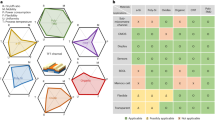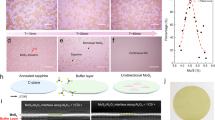Abstract
Van der Waals dielectrics, such as hexagonal boron nitride, are widely used to preserve the intrinsic properties of two-dimensional semiconductors in electronic devices. However, fabricating these materials on the wafer scale and integrating them with two-dimensional semiconductors is challenging because their synthesis typically requires mechanical exfoliation or vapour deposition processes. Here we show that a high-κ van der Waals dielectric can be created on wafer scales using an inorganic molecular crystal film of antimony trioxide (Sb2O3) fabricated via thermal evaporation deposition. Monolayer molybdenum disulfide (MoS2) field-effect transistors supported by this dielectric substrate exhibit enhanced electron mobility—from 26 cm2 V−1 s−1 to 145 cm2 V−1 s−1—and reduced transfer-curve hysteresis compared with when using SiO2 substrate. MoS2 transistors directly gated by the Sb2O3 film can operate with a supply voltage of 0.8 V, on/off ratio of 108 and subthreshold swing of 64 mV dec−1 at 300 K.
This is a preview of subscription content, access via your institution
Access options
Access Nature and 54 other Nature Portfolio journals
Get Nature+, our best-value online-access subscription
$29.99 / 30 days
cancel any time
Subscribe to this journal
Receive 12 digital issues and online access to articles
$119.00 per year
only $9.92 per issue
Buy this article
- Purchase on Springer Link
- Instant access to full article PDF
Prices may be subject to local taxes which are calculated during checkout





Similar content being viewed by others
Data availability
The data that support the plots within this paper and other finding of this study are available from the corresponding author upon reasonable request.
References
Radisavljevic, B., Radenovic, A., Brivio, J., Giacometti, V. & Kis, A. Single-layer MoS2 transistors. Nat. Nanotechnol. 6, 147–150 (2011).
Li, L. et al. Black phosphorus field-effect transistors. Nat. Nanotechnol. 9, 372–377 (2014).
Kang, K. et al. High-mobility three-atom-thick semiconducting films with wafer-scale homogeneity. Nature 520, 656–660 (2015).
Liu, Y., Duan, X., Huang, Y. & Duan, X. Two-dimensional transistors beyond graphene and TMDCs. Chem. Soc. Rev. 47, 6388–6409 (2018).
Aljarb, A. et al. Ledge-directed epitaxy of continuously self-aligned single-crystalline nanoribbons of transition metal dichalcogenides. Nat. Mater. 19, 1300–1306 (2020).
Dean, C. R. et al. Boron nitride substrates for high-quality graphene electronics. Nat. Nanotechnol. 5, 722–726 (2010).
Rhodes, D., Chae, S. H., Ribeiro-Palau, R. & Hone, J. Disorder in van der Waals heterostructures of 2D materials. Nat. Mater. 18, 541–549 (2019).
Wang, L. et al. One-dimensional electrical contact to a two-dimensional material. Science 342, 614–617 (2013).
Cui, X. et al. Multi-terminal transport measurements of MoS2 using a van der Waals heterostructure device platform. Nat. Nanotechnol. 10, 534–540 (2015).
Cadiz, F. et al. Excitonic linewidth approaching the homogeneous limit in MoS2-based van der Waals heterostructures. Phys. Rev. X 7, 021026 (2017).
Cao, Y. et al. Unconventional superconductivity in magic-angle graphene superlattices. Nature 556, 43–50 (2018).
Lee, G. et al. Flexible and transparent MoS2 field-effect transistors on hexagonal boron nitride-graphene heterostructures. ACS Nano 7, 7931–7936 (2013).
Lee, G.-H. et al. Highly stable, dual-gated MoS2 transistors encapsulated by hexagonal boron nitride with gate-controllable contact, resistance, and threshold Voltage. ACS Nano 9, 7019–7026 (2015).
Xue, J. et al. Scanning tunnelling microscopy and spectroscopy of ultra-flat graphene on hexagonal boron nitride. Nat. Mater. 10, 282–285 (2011).
Decker, R. et al. Local electronic properties of graphene on a BN substrate via scanning tunneling microscopy. Nano Lett. 11, 2291–2295 (2011).
Kim, S. M. et al. Synthesis of large-area multilayer hexagonal boron nitride for high material performance. Nat. Commun. 6, 8662 (2015).
Chen, T. A. et al. Wafer-scale single-crystal hexagonal boron nitride monolayers on Cu (111). Nature 579, 219–223 (2020).
Illarionov, Y. et al. Ultrathin calcium fluoride insulators for two-dimensional field-effect transistors. Nat. Electron. 2, 230–235 (2019).
Wang, L. et al. Epitaxial growth of a 100-square-centimetre single-crystal hexagonal boron nitride monolayer on copper. Nature 570, 91–95 (2019).
Svensson, C. Refinement of the crystal structure of cubic antimony trioxide, Sb2O3. Acta Crystallogr. B 31, 2016–2018 (1975).
Pereira, A. L. J. et al. Structural and vibrational study of cubic Sb2O3 under high pressure. Phys. Rev. B 85, 174108 (2012).
Han, W. et al. Two-dimensional inorganic molecular crystals. Nat. Commun. 10, 4728 (2019).
Zhou, Y. et al. Thin-film Sb2Se3 photovoltaics with oriented one-dimensional ribbons and benign grain boundaries. Nat. Photon. 9, 409–415 (2015).
Wang, Y. et al. Van der Waals contacts between three-dimensional metals and two-dimensional semiconductors. Nature 568, 70–74 (2019).
Late, D. J. et al. Hysteresis in single-layer MoS2 field effect transistors. ACS Nano 6, 5635–5641 (2012).
Liu, Y., Stradins, P. & Wei, S.-H. Van der Waals metal–semiconductor junction: weak Fermi level pinning enables effective tuning of Schottky barrier. Sci. Adv. 2, e1600069 (2016).
Amit, I. et al. Role of charge traps in the performance of atomically thin transistors. Adv. Mater. 29, 1605598 (2017).
Lee, C.-H. et al. Atomically thin p–n junctions with van der Waals heterointerfaces. Nat. Nanotechnol. 9, 676–681 (2014).
Illarionov, Y. Y. et al. The role of charge trapping in MoS2/SiO2 and MoS2/hBN field-effect transistors. 2D Mater. 3, 035004 (2016).
McDonnell, S. et al. HfO2 on MoS2 by atomic layer deposition: adsorption mechanisms and thickness scalability. ACS Nano 7, 10354–10361 (2013).
Li, W. et al. Uniform and ultrathin high-κ gate dielectrics for two-dimensional electronic devices. Nat. Electron. 2, 563–571 (2019).
Datye, I. M. et al. Reduction of hysteresis in MoS2 transistors using pulsed voltage measurements. 2D Mater. 6, 011004 (2019).
Illarionov, Y. Y. et al. Improved hysteresis and reliability of MoS2 transistors with high-quality CVD growth and Al2O3 encapsulation. IEEE Electron Device Lett. 12, 1763–1766 (2017).
Jung, Y. et al. Transferred via contacts as a platform for ideal two-dimensional transistors. Nat. Electron. 2, 187–194 (2019).
Li, T. et al. A native oxide high-κ gate dielectric for two-dimensional electronics. Nat. Electron. 3, 473–478 (2020).
Knobloch, T. et al. The performance limits of hexagonal boron nitride as an insulator for scaled CMOS devices based on two-dimensional materials. Nat. Electron. 4, 98–108 (2021).
Britnell, L. et al. Field-effect tunneling transistor based on vertical graphene heterostructures. Science 335, 947–950 (2012).
Ju, L. et al. Photoinduced doping in heterostructures of graphene and boron nitride. Nat. Nanotechnol. 9, 348–352 (2014).
Vu, Q. A. et al. Two-terminal floating-gate memory with van der Waals heterostructures for ultrahigh on/off ratio. Nat. Commun. 7, 12725 (2016).
Acknowledgements
This work was supported by the National Nature Science Foundation of China (21825103, 51727809 and 11904154), the Hubei Provincial Nature Science Foundation of China (2019CFA002) and the Fundamental Research Funds for the Central Universities (2019kfyXMBZ018). We also acknowledge the Analytical and Testing Center of Huazhong University of Science and Technology for the TEM characterizations and analysis. Computational time is partially supported by the Center for Computational Science and Engineering of Southern University of Science and Technology. We thank X. Shi (Hebei University) and B. Deng (Shenzhen JL Computational Science and Applied Research Institute) for the fruitful discussions about the theoretical calculations. We also appreciate the inspiring discussions with S. Hu and Y. Cao (Xiamen University).
Author information
Authors and Affiliations
Contributions
K.L. and T.Z. conceived the ideas. K.L. and B.J. designed and carried out most of the experiments under T.Z.’s supervision. K.L., B.J. and X.H. deposited the film. K.L. and J.D. performed the measurement of the absorption spectrum. P.G. and L.H. carried out the first-principles calculations. X.C., L. Li., S.Y. and F.Z. helped to analyse the data. K.L., W.H., L. Liu. and T.Z. worked on the images with assistance from all the others. K.L. wrote the paper with inputs from all the authors.
Corresponding author
Ethics declarations
Competing interests
The authors declare no competing interests.
Additional information
Peer review information Nature Electronics thanks Yury Illarionov and the other, anonymous, reviewer(s) for their contribution to the peer review of this work.
Publisher’s note Springer Nature remains neutral with regard to jurisdictional claims in published maps and institutional affiliations.
Supplementary information
Supplementary Information
Supplementary Figs. 1–23 and Tables 1–5.
Rights and permissions
About this article
Cite this article
Liu, K., Jin, B., Han, W. et al. A wafer-scale van der Waals dielectric made from an inorganic molecular crystal film. Nat Electron 4, 906–913 (2021). https://doi.org/10.1038/s41928-021-00683-w
Received:
Accepted:
Published:
Issue Date:
DOI: https://doi.org/10.1038/s41928-021-00683-w
This article is cited by
-
Two-dimensional perovskite oxide as a photoactive high-κ gate dielectric
Nature Electronics (2024)
-
Vertically grown ultrathin Bi2SiO5 as high-κ single-crystalline gate dielectric
Nature Communications (2023)
-
Single-crystalline van der Waals layered dielectric with high dielectric constant
Nature Materials (2023)
-
Scalable integration of hybrid high-κ dielectric materials on two-dimensional semiconductors
Nature Materials (2023)
-
Wafer-scale transistor arrays fabricated using slot-die printing of molybdenum disulfide and sodium-embedded alumina
Nature Electronics (2023)



